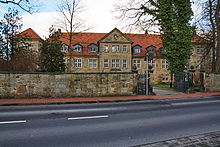Barsinghausen Monastery
Barsinghausen Monastery is a Protestant women's monastery in Barsinghausen in the Hanover region . It is one of the five Calenberg monasteries administered by the Hannover Monastery Chamber.
history

Oil painting by Sir Godfrey Kneller in Barsinghausen Monastery
Barsinghausen Monastery was first mentioned in a document in 1193. The monastery was founded by Count Wedekind von Schwalenberg a few years earlier as a double monastery (Augustinian canons and Augustinian choir women), but from 1229 the chronicle only lists nuns. It is the oldest of the five women's convents located in the former Principality of Calenberg . In 1543 the Reformation was introduced into the monastery and the monastery was transferred to the Hanover monastery chamber. Since then, the monastery church of St. Marien has also been the parish church of the Evangelical Lutheran St. Mary's parish. After severe damage to the building during the Thirty Years' War , it was only rebuilt in the years 1700 to 1704.
At last the monastery was only inhabited by a few conventual women. Since 1996 the sisters of the Evangelical Community of Barsinghausen Abbey have continued the monastic rhythm of “ pray and work ” (ora et labora). The community is part of the Diakonischen Schwesternschaft Wolmirstedt eV, which was founded in 1954 near Magdeburg . The life of the sisters in the monastery is based on the three evangelical counsels : community of property, celibacy and obedience.
Monastery building
The castle-like, well-proportioned monastery buildings were built by Georg Sigismund Schmidt in the years 1700–1704 and are located to the south above the monastery church. The single-storey tracts built in the square include the church on one side. There are three double-storey risalits at the corners ; the southern front is emphasized by a central projectile with a triangular gable. The monastery is surrounded by a quarry stone wall. There is a draw well and a baroque sundial in the garden.
House Inspiratio
During the synod in mid-2013, the then President of the Hanover Regional Church Office, Guntau, presented the developments in the Inspiratio House. The Inspiratio House is a joint institution of the Evangelical Lutheran Church of Hanover , the Evangelical Church of Westphalia and the Evangelical Church in Hesse and Hesse Nassau . The facility is intended to give pastors and other employees of the regional churches the opportunity to calm down and to prevent and counter possible burn-out or states of exhaustion. There are several apartments and offers such as seminars and programs with suggestions from the fields of music and art. It should serve the inner contemplation. It is one of only three institutions of its kind in Germany. The House of Inspiratio is administered by the House of Church Services of the Regional Church of Hanover.
literature
- Wolfgang Ewig: Portrait pictures of Ludwig Maximilian Mehmet von Königstreu and his descendants in the Barsinghausen monastery. Heimatbund Niedersachsen eV - Barsinghausen Group, Barsinghausen 1993.
- Wolfgang Ewig, Christian Pietsch: Stone witnesses of the past. The tombs in Barsinghausen Monastery. Wildhagen, Barsinghausen 1994, ISBN 3-9803489-0-3 .
- Achim Bonk (edit.): Document book of the Barsinghausen monastery (= publications of the Historical Commission for Lower Saxony and Bremen. (VHKNB). Vol. 37 = Sources and studies on the history of Lower Saxony in the Middle Ages. Vol. 21). Hahnsche Buchhandlung, Hannover 1996, ISBN 3-7752-5892-2 .
Web links
Individual evidence
- ^ Georg Dehio : Handbook of German Art Monuments. Bremen - Lower Saxony. Deutscher Kunstverlag, Munich, Berlin 1992, ISBN 3-422-03022-0 , p. 194.
Coordinates: 52 ° 18 ′ 2.5 ″ N , 9 ° 27 ′ 39.8 ″ E
